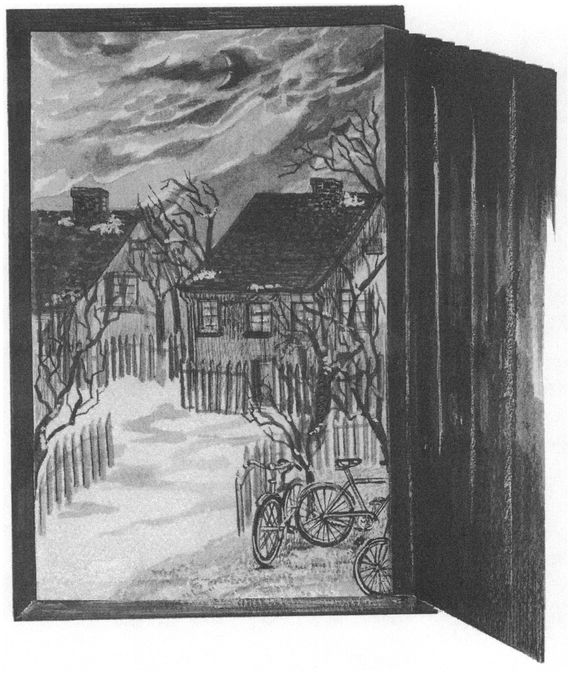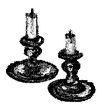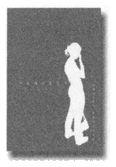Behind the Bedroom Wall (17 page)
Read Behind the Bedroom Wall Online
Authors: Laura E. Williams

Korinna could only nod mutely in reply.
Her mother gave her one last squeeze and then followed Herr Rehme out of the room. Korinna went to the hanging picture of the Führer and took it off the wall. Tied to the back of it were Rachel's drawings. She put them in the bag. She looked around her room. What else did she need? She gathered some undergarments, a sweater, a wool skirt, and an extra scarf. All of this fit into her book bag with hardly any room to spare. She found a few sheets of paper and a pencil in the mess on the floor, and stuffed those on top of everything and closed the leather bag.
Taking the bag with her and tucking
Tag
under her arm, Korinna walked to her door and shut off the light. Looking back, she could barely see in the darkness that immediately took over her room. But that was better. In the dark she could imagine her room as it had been beforeâbefore all this. But no, she didn't want to remember it before the Krugmanns, as if they had never been here.
Tag
under her arm, Korinna walked to her door and shut off the light. Looking back, she could barely see in the darkness that immediately took over her room. But that was better. In the dark she could imagine her room as it had been beforeâbefore all this. But no, she didn't want to remember it before the Krugmanns, as if they had never been here.
She looked to where her wardrobe had stood. The hole in the wall was darker even than the room. It looked like a gaping wound.
Now she had to leave. She didn't know where she was going, but she had a feeling it was going to be her turn to hide behind someone else's bedroom wall, in a dark, small hole with barely enough air to breathe. And if she never came back to this house, it would be because ... because.... She couldn't bring herself to finish that thought.
She just hoped she would meet the Krugmanns again somedayâsomeday in the future when all people were free to speak and act without fear.
Suddenly, it dawned on her what could possibly be just as important as love, if not more so.
Freedom.
She ran to tell her parents.


Afterword
The story you have just read is about a fictional character named Korinna Rehme. Korinna, like eight million real children, belonged to one of Hitler's youth groups that existed before and during World War II.
Why did children get so involved in their youth groups, even to the point of reporting “un-German” teachers, friends, and parents? Research and interviews have since shown that these girls and boys were brainwashed into believing what they did was for a good cause.
In 1933, Germany was in a depression. Poor and out of work, many people looked for someone to lead them to a brighter future. Hitler promised to do this.
Hitler said he would create a strong country and a Thousand-Year Reich, yet no one knew how he would do this. But because everyone wanted it so desperately, they followed him blindly.
Children, especially, were affected. And why not?
They had a lot of fun at their Hitler youth group meetings. They sang, hiked, helped the elderly, raised money, and baked. They marched in parades and practiced sports. And because Hitler controlled all the radio broadcasts, all the newspapers and books that were printed, the children truly believed that they were helping him create a wonderful, strong Fatherland. All they had to do was commit their lives to the cause, report anyone who seemed un-German, and hate the enemies.
They had a lot of fun at their Hitler youth group meetings. They sang, hiked, helped the elderly, raised money, and baked. They marched in parades and practiced sports. And because Hitler controlled all the radio broadcasts, all the newspapers and books that were printed, the children truly believed that they were helping him create a wonderful, strong Fatherland. All they had to do was commit their lives to the cause, report anyone who seemed un-German, and hate the enemies.
But who were the enemies? Anyone who looked different. Anyone who acted different. The followers of Hitler specifically targeted Jews (and anyone who helped them), Eastern Europeans, mentally and physically challenged people, gypsies, and homosexuals, to name a few.
Hitler's followers murdered over six million Jews and millions of other people, too, before and during World War II. It is estimated that, by the end of the war, over two-thirds of the Jews in Europe had been murdered. Well over one million of them were children like Rachel.
Even knowing they could be killed for helping “the enemy,” some Gentiles (non-Jewish people like the Rehmes), especially outside Germany, put their lives in danger to help the victims. Ten thousand Rachels may have survived because of these decent human beings. Because no records were kept of hidden children, it is impossible to know if this number is
accurate or if as many as several hundred thousand children survived.
accurate or if as many as several hundred thousand children survived.
I ended this novel with Korinna's realization that freedom is perhaps more important than love. After all, if you're not free to love whom you wish, what good is love?
Laura E. Williams was born in Seoul, Korea, and adopted when she was one and a half. Since then she has lived in Belgium, Hawaii, Ohio, and Connecticut. Always an avid traveler, she has driven across much of America and Canada, visited Russia on a student/teacher exchange, backpacked through most of Europe, worked on a cruise ship in Tahiti, and lived on a sailboat in the Caribbean. Laura now lives in Connecticut where she teaches high school and college English. With over thirty published books, she continues to write every chance she gets.
If you enjoyed this book, you'll also want to read these other Milkweed novels.
Â
To order books or for more information, contact Milkweed at (800) 520-6455 or visit our Web site (
www.milkweed.org
).
www.milkweed.org
).

The $66 Summer
John Armistead
Milkweed Prize for Children's Literature New York Public Library Best Books of the Year: “Books for the Teen Age”
Â
A story of interracial friendships in the segregation-era South.

The Return of Gabriel
John Armistead
Â
A story of Freedom Summer.

The Ocean Within
V. M. Caldwell
Â
Milkweed Prize for Children's Literature
Â
Focuses on an older child adopted into a large, extended family.

Tides
V. M. Caldwell
Â
The sequel to
The Ocean Within
, this book deals with the troubles of older siblings.
The Ocean Within
, this book deals with the troubles of older siblings.

Alligator Crossing
Marjory Stoneman Douglas
Â
Features the wildlife of the Everglades just before it was declared a national park.

Perfect
Other books
Bloodmoney by David Ignatius
The Suicide Club by Gayle Wilson
Life Swap by Jane Green
Forgotten Father by Carol Rose
Third Strike by Heather Brewer
Slaves of Hyperion (Star Crusades Uprising, Book 6) by Thomas, Michael G.
Pick-me-up by Cecilia La France
The Invisible Life of Ivan Isaenko by Scott Stambach
Murder With Sarcastic Intent by Dani Amore
By the Rivers of Brooklyn by Trudy Morgan-Cole